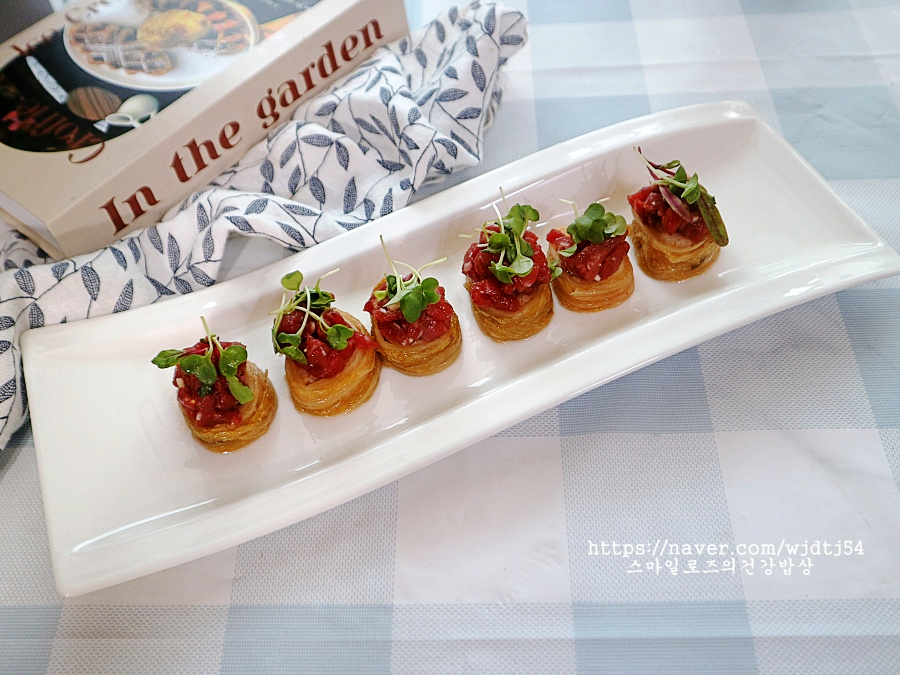Aged Kimchi and Yukhoe (Beef Tartare) Kimbap
Chef Lee Sang-yeop’s Aged Kimchi Kimbap Recipe from ‘Pyeonstaurant’: The Perfect Harmony of Crunchy Aged Kimchi and Fresh Yukhoe!

This recipe for ‘Aged Kimchi Yukhoe Kimbap’ is a special twist on the Aged Kimchi Kimbap featured by Chef Lee Sang-yeop on the TV show ‘Pyeonstaurant’, elevated with fresh Korean beef tartare (yukhoe). The combination of deeply flavored, well-fermented aged kimchi and tender, fresh yukhoe is simply exquisite. The golden ratio of seasoning for the rice and the marinade for the beef further enhances the taste. The spicy and sour notes of the aged kimchi, the nutty aroma of perilla oil, and the rich flavor of the yukhoe come together to create a delightful culinary experience. Make this wonderful dish easily at home, perfect for special occasions or when hosting guests!
Main Ingredients- Aged Kimchi (Mugeunji) 600g (approx. 1/2 head)
- Fresh Korean Beef Sirloin for Yukhoe 200g
- Freshly Cooked Rice 1 serving (approx. 130g)
- Scallions for garnish (optional)
Beef Marinade- 1 Tbsp Minced Garlic
- 2 Tbsp Hongge Soy Sauce (or Korean soup soy sauce)
- 5 Tbsp Perilla Oil
- 5 Tbsp Sugar
Rice Seasoning- 1 Tbsp Sesame Oil
- 1 Pinch Salt
- A little Toasted Sesame Seeds
- 1 Tbsp Minced Garlic
- 2 Tbsp Hongge Soy Sauce (or Korean soup soy sauce)
- 5 Tbsp Perilla Oil
- 5 Tbsp Sugar
Rice Seasoning- 1 Tbsp Sesame Oil
- 1 Pinch Salt
- A little Toasted Sesame Seeds
Cooking Instructions
Step 1
Thoroughly rinse the aged kimchi under running water to remove excess seasoning. Soak the kimchi in cold water for about 30 minutes to draw out the saltiness. You can taste a piece of the kimchi after soaking to gauge its saltiness and adjust the soaking time accordingly. The kimchi will become palatable enough to eat as is, perhaps even in wraps.

Step 2
Squeeze out excess water from the rinsed aged kimchi and trim off any tough ends for a cleaner presentation. If you find it difficult to squeeze out the water by hand, a manual juicer or strainer can be very helpful. Using a tool like this helps retain the kimchi’s crisp texture, making it a delightful side for wraps, especially when you crave something refreshing during hot weather.

Step 3
To the squeezed aged kimchi, add 5 tablespoons of sugar and 5 tablespoons of perilla oil. Gently mix and massage the ingredients into the kimchi until well combined. This seasoned kimchi is delicious enough to be enjoyed on its own as a side dish.

Step 4
Pat the beef for yukhoe dry with paper towels to remove any excess blood. Prepare the yukhoe marinade by setting aside a portion for later. Following Chef Lee Sang-yeop’s recipe, marinate the beef sirloin with 2 tablespoons of Hongge soy sauce, 1 tablespoon of sugar, 1 tablespoon of minced garlic, and 1 tablespoon of sesame oil, mixing gently. (Tip: If Hongge soy sauce is unavailable, you can substitute it with Korean soup soy sauce or fish sauce. Adjust the sugar amount to your preference. The original recipe used 5 Tbsp sugar, but I personally found 0.5 Tbsp sufficient.)

Step 5
Season the freshly cooked warm rice with 1 tablespoon of sesame oil, a pinch of salt, and a sprinkle of toasted sesame seeds. Mix well with a spatula, ensuring the rice grains don’t clump together.

Step 6
Prepare all your components for rolling the kimbap: the seasoned aged kimchi, the marinated fresh yukhoe, and the seasoned rice. Everything is now ready for assembly.

Step 7
Lay a sheet of nori (seaweed) on a kimbap rolling mat. Spread the seasoned aged kimchi evenly over the nori, slightly overlapping the pieces to prevent it from falling apart when rolled. Shape the seasoned rice into a long log and place it on top of the kimchi. Then, roll the kimbap tightly, using the kimchi to encase the filling. Rolling with the kimchi on the outside will create a visually appealing kimbap when sliced.

Step 8
Slice the rolled aged kimchi kimbap into bite-sized pieces. To achieve clean cuts and prevent the kimbap from getting squished, lightly dampen your knife with water before slicing.

Step 9
Arrange the sliced kimbap on a serving plate. Top each piece with a portion of the marinated yukhoe. Finally, garnish with finely chopped scallions or young sprouts for a fresh finish. (Tip: If scallions are unavailable, you can use finely chopped carrots or perilla leaves as a garnish.)

Step 10
The crisp texture of the aged kimchi, combined with the nutty and sweet flavors from the perilla oil and sugar, is truly delightful. Even without the yukhoe, the aged kimchi kimbap is delicious on its own. However, adding the fresh and savory yukhoe elevates the flavor profile, making each bite a joyful experience.

Step 11
I tried making this after seeing it on television, and the taste was so uniquely amazing, I exclaimed, ‘This is truly a first for me!’ The deep flavors of the aged kimchi and the freshness of the yukhoe blend perfectly.

Step 12
This recipe results in a wonderfully delicious and impressive dish that is surprisingly easy to make. It’s elegant enough to serve at any gathering.

Step 13
If you’re not a fan of raw beef or prefer not to use it, a creamy and savory tuna mayo filling would also be a delicious alternative to top the kimbap. The true joy of cooking lies in adapting recipes to suit everyone’s preferences and utilizing ingredients you have on hand to create something special. Making a unique dish with what you have is the essence of great cooking.

Step 14
Are you wondering what to make this weekend? Consider making this Aged Kimchi Yukhoe Kimbap with your family for a fun and delicious meal. Enjoy your cooking!




